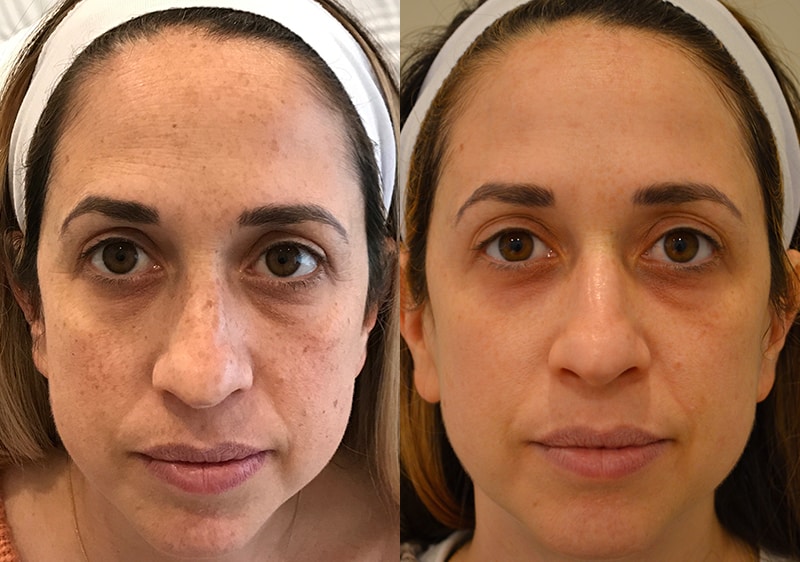A photofacial is a skin treatment that uses light to improve the look of your skin. It can help with things like sun damage, age spots, and redness. This article explains all about photofacials, including the cost, what to expect during recovery, and everything else you need to know.

Image Source: freshfaceandeye.com
Delving into Photofacials
A photofacial, often called Intense Pulsed Light (IPL) therapy, is a non-invasive procedure that uses light energy to rejuvenate your skin. It targets various skin issues, leaving you with a clearer, more even complexion.
What is Intense Pulsed Light?
Intense Pulsed Light (IPL) is a technology that uses broad-spectrum light to treat various skin conditions. Unlike lasers, which use a single wavelength of light, IPL uses multiple wavelengths. This allows it to target different chromophores (color-absorbing components) in the skin, such as melanin (pigment) and hemoglobin (redness). The light energy is converted to heat, which damages the targeted cells, prompting the body’s natural healing process to remove them and replace them with new, healthy cells.
Types of Photofacials
While “photofacial” often refers to IPL treatments, other light-based therapies exist. Here’s a quick overview of common types:
- IPL (Intense Pulsed Light): Treats discoloration, sun damage, and redness.
- LED (Light Emitting Diode) Therapy: Uses different colors of light to address specific concerns like acne (blue light) and inflammation (red light).
- Laser Resurfacing: More aggressive than IPL, lasers remove layers of skin to treat wrinkles and scars. (This is generally not considered a photofacial, but often mistaken.)
IPL Photofacial Benefits
Photofacials offer a multitude of benefits for various skin concerns.
- Reduces Sun Damage: Fades sunspots, age spots, and freckles.
- Evens Skin Tone: Improves overall skin tone and texture.
- Minimizes Redness: Reduces the appearance of rosacea and broken capillaries.
- Treats Hyperpigmentation: Lightens dark spots and melasma.
- Reduces Fine Lines: Stimulates collagen production for smoother skin.
- Improves Acne Scars: Can lessen the appearance of some acne scars.
- Treats Enlarged Pores: Can help to shrink the appearance of enlarged pores.
Photofacial for Rosacea
A photofacial for rosacea can be a game-changer. IPL specifically targets the blood vessels that cause redness and flushing, leading to a more even skin tone and reduced symptoms. Multiple sessions are typically needed for optimal results.
Photofacial for Acne Scars
While not a primary treatment for deep acne scars, a photofacial for acne scars can help improve the appearance of superficial scars by reducing redness and discoloration. For more severe scarring, other treatments like laser resurfacing or microneedling might be more effective.
The Photofacial Procedure: What to Expect
Knowing what to expect during the procedure can ease any anxiety.
- Consultation: You’ll first meet with a skincare professional to discuss your concerns and determine if a photofacial is right for you.
- Preparation: On the day of the treatment, your skin will be cleansed, and you’ll be given protective eyewear.
- Treatment: A cool gel will be applied to your skin, and the IPL device will be used to deliver pulses of light to the targeted areas. You might feel a warm or snapping sensation.
- Post-Treatment: The gel is removed, and a soothing cream or sunscreen is applied.
Photofacial Recovery
The recovery period after a photofacial is usually minimal.
- Immediately After: Your skin might be slightly red and feel like you have a mild sunburn.
- First Few Days: Sunspots may darken before flaking off. Avoid sun exposure and wear sunscreen.
- Within a Week: Redness should subside, and you’ll start to see improvements in your skin tone.
Photofacial Before and After
The photofacial before and after results can be impressive. Before the treatment, you might notice sunspots, redness, and uneven skin tone. After a series of sessions, many people experience a significant reduction in these concerns, resulting in a brighter, more youthful complexion.
Photofacial Side Effects
While generally safe, photofacials can have some potential side effects.
- Redness and Swelling: Usually mild and temporary.
- Blistering: Rare, but can occur if the treatment is too aggressive or if you have sensitive skin.
- Changes in Pigmentation: Hyperpigmentation (darkening of the skin) or hypopigmentation (lightening of the skin) can occur, especially in people with darker skin tones.
- Scarring: Very rare, but possible.
Photofacial Risks
It’s crucial to be aware of the potential photofacial risks before undergoing the procedure. Choosing a qualified and experienced provider can minimize these risks. People with certain skin conditions or those who are pregnant or breastfeeding may not be good candidates for photofacials.
Photofacial Treatment Cost
The photofacial treatment cost can vary depending on several factors:
- Location: Prices can vary based on your geographic location.
- Provider: The experience and expertise of the provider can influence the cost.
- Area Treated: Larger areas, like the full face and neck, will cost more than smaller areas.
- Number of Sessions: Multiple sessions are usually needed for optimal results, so the total cost will depend on the number of sessions required.
| Factor | Cost Range | Notes |
|---|---|---|
| Single Session | $300 – $600 | Average cost per session |
| Package of 3-6 | $900 – $3000 | Often more cost-effective than paying for individual sessions |
| Consultation Fee | $0 – $100 | Some providers offer free consultations, while others charge a fee |
These are average prices and may vary.
Maintaining Your Results
To prolong the results of your photofacial, follow these tips:
- Sun Protection: Wear sunscreen daily, even on cloudy days.
- Skincare Routine: Use gentle, hydrating skincare products.
- Avoid Harsh Chemicals: Avoid using harsh exfoliants or irritating ingredients.
- Maintenance Treatments: Schedule occasional maintenance sessions to keep your skin looking its best.
FAQ: Frequently Asked Questions About Photofacials
- How many photofacial treatments do I need?
- Most people need 3-6 treatments spaced 4-6 weeks apart for optimal results.
- Can I wear makeup after a photofacial?
- It’s generally recommended to avoid wearing makeup for 24 hours after the treatment.
- Are photofacials painful?
- Most people experience a mild snapping or stinging sensation during the treatment. A topical numbing cream can be used to minimize discomfort.
- Who is a good candidate for a photofacial?
- Ideal candidates have fair to medium skin tones and are looking to improve sun damage, redness, or uneven skin tone.
- Are there any alternatives to photofacials?
- Alternatives include chemical peels, microdermabrasion, and laser resurfacing. Your skincare professional can help you determine the best option for your skin.
- What skin types can have photofacials?
- Photofacials are typically most effective on light to medium skin tones. Darker skin tones have a higher risk of pigmentation changes.
- Can I do a photofacial at home?
- While there are at-home IPL devices available, they are generally less powerful and less effective than professional treatments. It’s important to follow the manufacturer’s instructions carefully and be aware of the potential risks.
- Is it possible to get a tan after photofacial?
- Getting a tan after photofacial is not recommended and should be avoided as it can increase the risk of hyperpigmentation and other side effects.

I’m Carrie Kelly, the creator behind Gotham Beauty Lounge. Beauty is my passion, and I’ve made it my mission to bring you all the latest trends, expert tips, and honest reviews to help you elevate your beauty game. With a love for all things bold, edgy, and elegant, I believe makeup is an art form, and skincare is self-care. On my blog, I share my personal experiences, favorite products, and advice for embracing your unique beauty. Join me on this exciting journey to feel confident, empowered, and, most importantly, to always look and feel your best!
